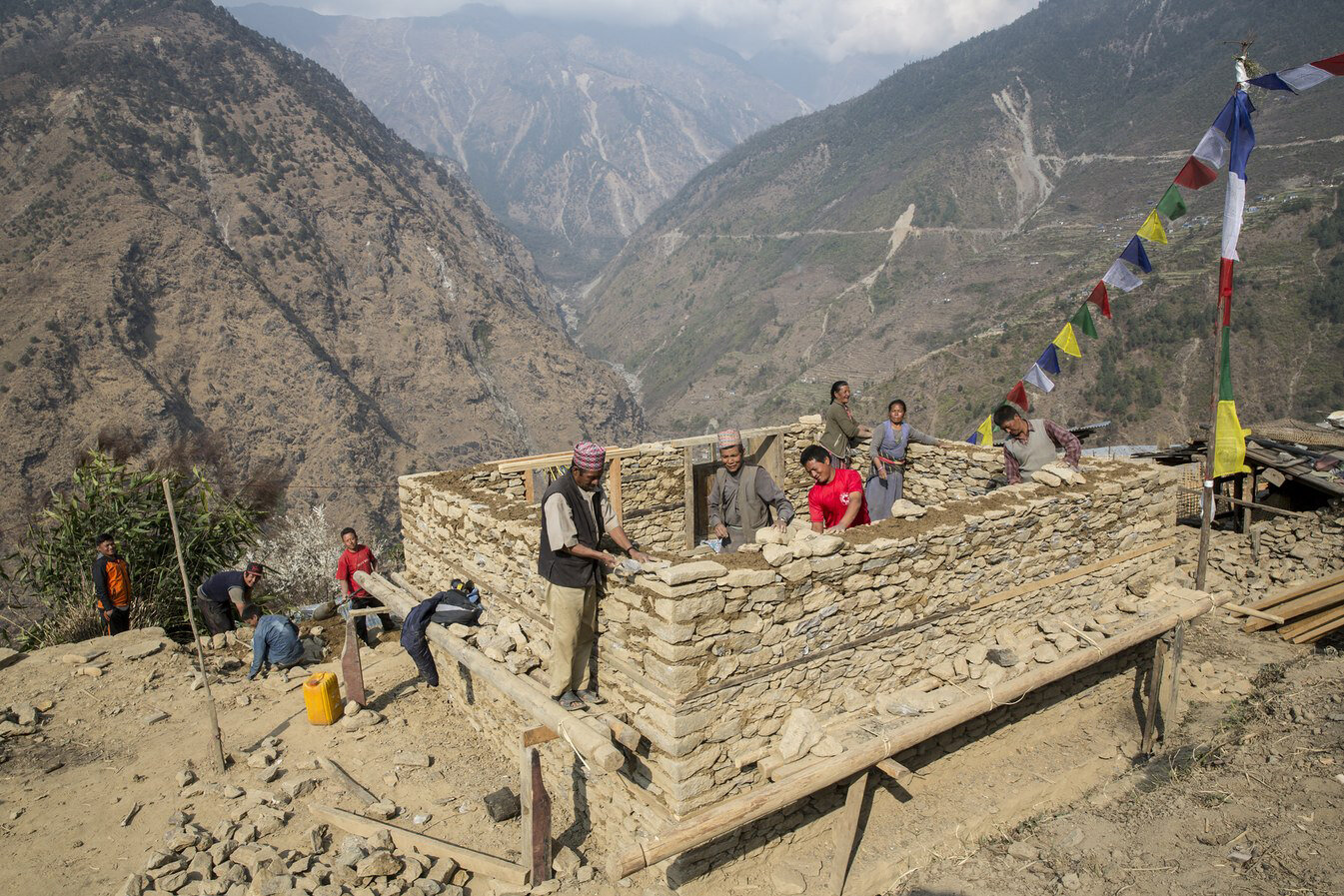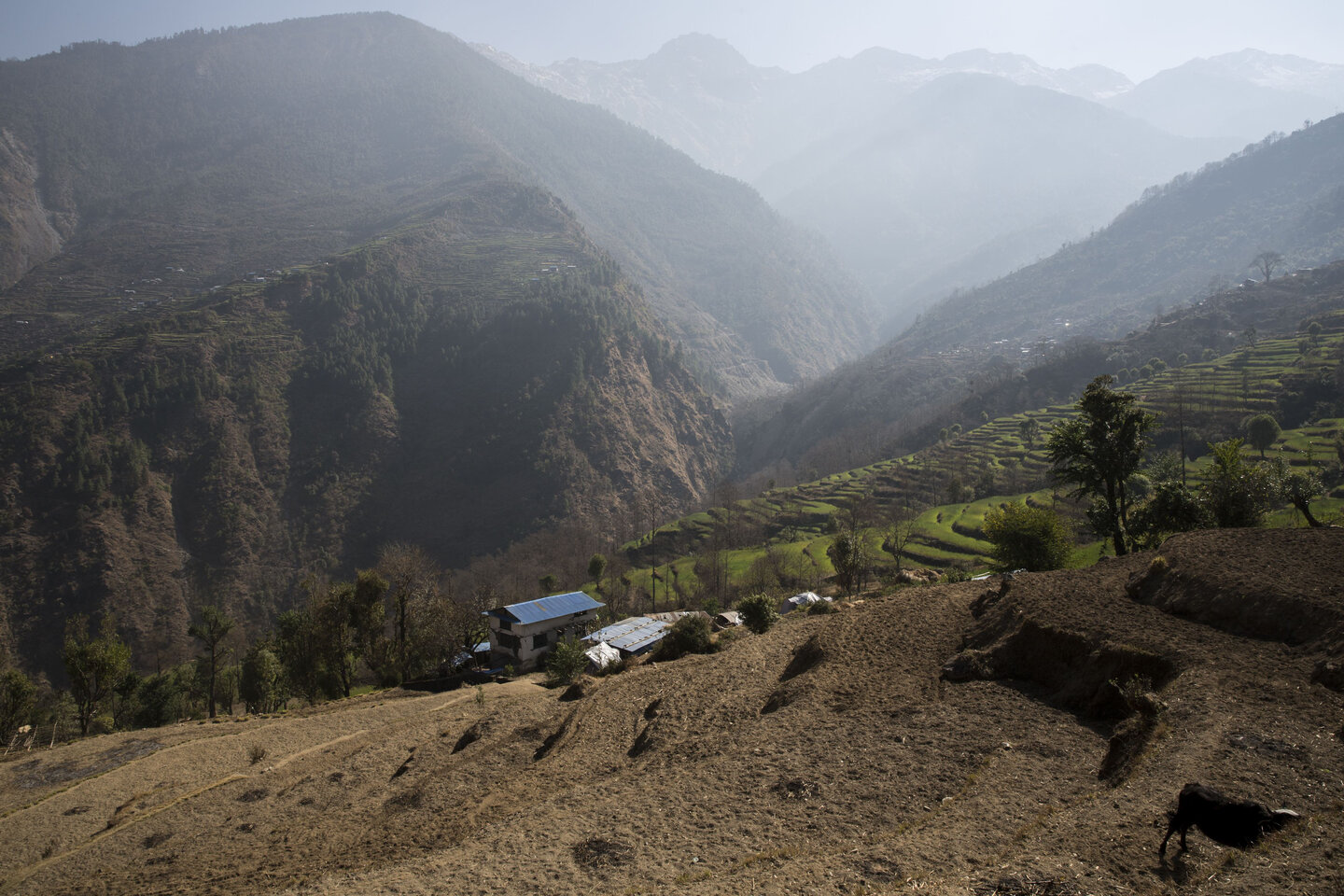One year after the earthquakes hit Nepal
It’s late afternoon in Marbu, the springtime sunshine steeps the village at the foot of the Himalayas in a warm light. We meet Daulima Sherpa at a little square located next to her new house. Kneeling on a plastic tarp, she is winnowing the chaff from the dried millet. Daulima, now 40 years old, has been through a very tough year. But soon she can move into her new house. It’s the first house to be built in Marbu after last year’s devastating earthquakes.

The two earthquakes, on 25 April and 12 May 2015, destroyed a total of 750,000 houses in Nepal and claimed over 8,800 lives. Marbu, with its widely scattered new hamlets, lies in Dolakha, one of the districts hardest hit by the disaster.
Marbu is located at the far end of a remote side valley, about nine hours’ drive from Kathmandu. The first quake caused relatively little damage in Marbu because the epicentre was a little farther away. But after the second one, nearly as forceful as the first, hit three weeks later, not a single house in Marbu was habitable. In one fell swoop, all 1900 villagers were homeless. Fortunately, no one was hurt.
Daulima’s family house stood on the upper edge of the largest hamlet. It was the home of her husband’s parents. Nim Tsiring, whom she’d married at a young age, had died in January 2015, just three months before the first quake. Daulima doesn’t know what he died of. He just got weaker and weaker and then suddenly passed away, recounts Daulima. Since then she has had to take care of her four children and her 92-year-old mother-in-law all by herself.
Daulima 40, farmer's wife and earthquake victim
Accompanied by her two youngest sons, Sukima (13) and Ando (9), she leads us to the rubble of what used to their house. The house was no longer safe after the first earthquake, it collapsed after the second. Daulima fights back the tears as she stands before the ruins of her old house. It was a traditional multi-storied house made of stone. Daulima tells us what it looked like before disaster struck.
Daulima was working in the fields the day the heavy earthquake struck. She has three cows and a goat, and since she lost her husband she’s been helping out other farmers in the village now and then for low wages. It was afternoon when the ground started shaking violently. Daulima watched as houses collapsed.
“My only thought was: where are my children?”
Daulima was petrified at first, people were screaming everywhere. Then she ran to look for her children. She was lucky to find her sons close by. She took them up to her house up on the steep slope: it had caved in, the roof lay on the floor.
She went down to the road that runs through the village, where her family owns a piece of land they used to farm. Before night fell, she managed to jerry-rig a temporary shelter for her children and mother-in-law with the help of her sons and neighbours. “The earth went on shaking all night long. We sat there together terrified.”
From that day on, the shelter was their new home.This simple shack made of bamboo and woven mats serves to this day as the family’s kitchen and living room as well as sleeping quarters for her second-eldest son, Mingma (17), and her mother-in-law. Daulima sleeps with her two youngest sons just a few steps away from the shack in a tent she received only a few days after the earthquake. The new house is located right beside it. “At first the children didn’t want to sleep in the tent, but we had no choice.” Daulima is glad that these makeshift arrangements will soon be over.
The only thing missing in the new house is plaster on the inside walls. It’s a one-storey house with two rooms, which Daulima is going to share with her three youngest sons. Her eldest son, Nima (20), had already left before the earthquake to seek employment as a migrant worker in Malaysia, like many young Nepalis. When he has earned enough money for his mother, his brothers and himself, he plans to come back and build a house of his own on his parents’ property. The new house is a source of pride and delight to Daulima.

Helvetas has been contracted by the Swiss Agency for Development and Cooperation to teach 3,000 Nepalis – people who lost their houses in the earthquakes – how to build earthquake-proof houses by the end of 2016. In a 50-day course, 80 per cent of which is devoted to practical training and 20 per cent to theory, the trainees are instructed in the essentials of constructing quake-proof houses, 4,000 of which are to be built by the end of 2018.
Daulima 40, farmer's wife and earthquake victim
Daulima was among the first group of local trainees. And her house was also the first to be built. The village community decided that as a widow with several children, she was most in need of a house – which then served as a model for the practical training.
Thanks to the training, Daulima has not only helped build her own house, but also those of other trainees. Furthermore, these freshly-trained construction workers are being untrained villagers, which provides them with a supplementary source of income.

The requisite know-how for a quake-proof house
Mitra Tamang (35) was also trained by Helvetas in quake-proof construction. After working abroad, Mitra, the father of two small children, returned to Marbu shortly before the earthquake and made a living raising chickens and growing vegetables. Mitra’s house was the second to be rebuilt. Thanks to the training, he has found a new occupation. Mitra, who only went to school for five years and never had an opportunity to learn a trade, now makes a living as a construction worker.
Mitra Tamang, 35 years old
Mitra’s house will soon be finished too. It’s still missing a roof and plaster on the inside walls. Like Daulima, Mitra is glad the makeshift housing will soon be a thing of the past. But he’s even happier that he and his family will soon be able to sleep secure in the knowledge that their new house is earthquake-resistant. Out in the yard in front of his almost-finished new house, he explains to us the differences from his old house, which was completely destroyed by the earthquake.
So you need various elements to make a local stone house quake-proof. Mitras’s trainer Rajendra Panti (28) (bottom left) and his colleague Bishnu Bishwokarma (22) point out key features of Daulima’s house. Of vital importance are the horizontal wooden cross-braces inside and out, which are laid on the wall on a total of four levels starting from the foundations. The double frames around the doors and windows give additional stability.
For the corners of each house, stones are hewn into stable blocks, which are also longer and wider than the stones otherwise used to build 50-cm-thick walls. Since more load-bearing walls provide more stability, several rooms are fitted out with strong interior walls. And since a heavy stone roof can cause a great deal of damage, these light-weight roofs are made of wood and corrugated sheeting. Lastly, sturdy vertical supports in each corner and each interior wall give the house added stability.
After a rough year and a harsh winter, the people of Marbu are beginning to take heart again. Daulima, who lost her husband, her house and all her possessions last year, can now hope for a better future. And slowly but surely everyone in Marbu is going to have a roof over their heads again. A roof that can withstand even a powerful earthquake.
































